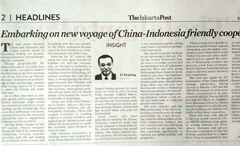China-Indonesia development synergy boosting bilateral, regional cooperation
2018-05-06
Xinhua
BEIJING — Being one of the overseas hubs within the framework of China’s Belt and Road Initiative, Indonesia is witnessing rapidly developing ties and increasingly fruitful cooperation with China.
The growing momentum in bilateral relations, experts say, is also helping strengthen the partnership between China and the Association of Southeast Asian Nations (ASEAN).
In recent years, China-Indonesia ties have enjoyed rapid development, fueled by the frequent high-level exchanges since the two countries established a comprehensive strategic partnership five years ago.
They have also aligned their development strategies, giving a stronger boost to their practical cooperation, which has borne rich fruit but still enjoys huge potential.
With Premier Li Keqiang traveling to Indonesia for an official visit, the two sides can work out more concrete measures to deepen and broaden bilateral cooperation, said Song Junying, deputy director of the Department for Asia-Pacific Security and Cooperation Studies at the China Institute of International Studies (CIIS).
Song suggested that the two countries carry out more major joint projects in such fields as industrial capacity cooperation and infrastructure construction.
Xu Liping, a senior research fellow with the National Institute of International Strategy at the Chinese Academy of Social Sciences, referred to the three pillars of China-Indonesia relations —politics and security, trade and business, as well as people-to-people interactions.
“The overall cooperation mechanism is smooth, with stable approaches established in all the three fields,” Xu told Xinhua.
China has been Indonesia’s largest trading partner for seven years in a row, and has also become a main source of foreign investment in the archipelagic country. Chinese official statistics show that in 2017, two-way trade reached $63.3 billion, up 18 percent year-on-year.
People-to-people exchanges are also increasing. The number of Chinese tourists to Indonesia reached 2 million last year, and Jakarta is trying to bring the volume to 3 million in 2018.
To Xu, it is very promising to link the 21st Century Maritime Silk Road, the maritime part of the Belt and Road Initiative that President Xi Jinping put forward in Indonesia in 2013, with Jakarta’s Global Maritime Fulcrum strategy.
Both initiatives envision comprehensive development encompassing infrastructure, industrial zones and so on, Xu said.
Although key programs are yet to be initiated, a good start has been seen in the operation of such joint industrial zones as Wuling Motors’ production facility in Indonesia, added the researcher.
Xu suggested that China get more involved in Indonesia’s infrastructure projects, as most parts of the Southeast Asian country are in dire need of efficient transportation.
Surrounded by a vast sea, Indonesia also needs to cooperate more with China in port construction and management, as well as on maritime issues like resource exploration and fishing, Xu said.
Such suggestions can also be applied to China-ASEAN cooperation, while development plans should be customized in accordance with the unique situations of different member states.
Besides cooperation with ASEAN, which has rolled out the Master Plan on ASEAN Connectivity 2025 for overall development, China can also take part in sub-regional mechanisms like the Lancang-Mekong Cooperation and the East ASEAN Growth Area, said Song, the CIIS scholar.
China’s active participation, he added, will bring more investment and help accelerate both the sub-regional and the overall development of ASEAN in a positive way.
“Interconnectivity is the premise, while industrial capacity cooperation serves as the basis, and people-to-people exchanges as the guarantee,” Song said.


